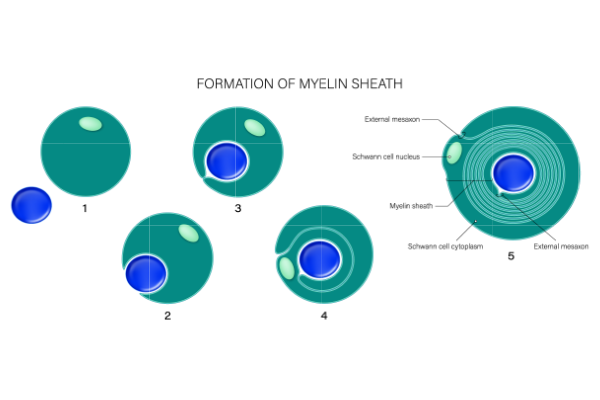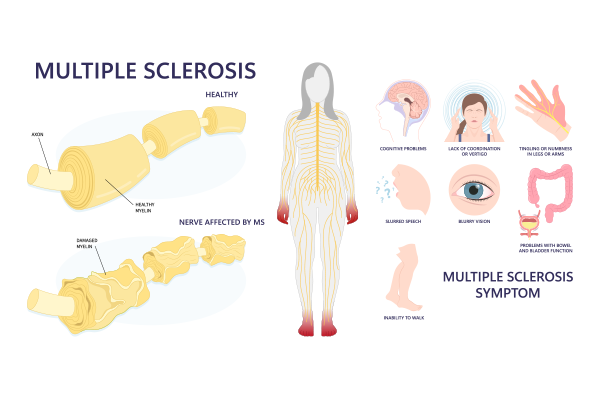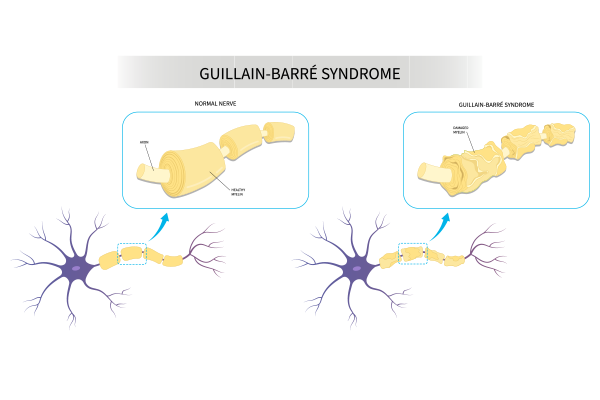
Demyelinating diseases are a group of disorders characterized by damage to the myelin sheath, the protective covering that surrounds nerve fibers in the central and peripheral nervous systems. This damage disrupts the normal transmission of electrical impulses along the nerves, leading to a wide range of neurological symptoms. Understanding these diseases, their demyelinating disease symptoms, and available demyelinating disease treatment is crucial for patients, caregivers, and healthcare providers.
Synopsis
What Are Demyelinating Diseases?
The myelin sheath is essential for the proper functioning of the nervous system. It acts as an insulator, allowing electrical impulses to travel quickly and efficiently along nerve cells. When the myelin sheath is damaged, the transmission of these impulses is slowed or blocked, leading to neurological deficits.

Demyelinating diseases can affect the central nervous system (CNS), including the brain and spinal cord, and the peripheral nervous system (PNS), which consists of nerves outside the CNS. The most well-known demyelinating disease is Multiple Sclerosis (MS). Still, there are several others, including Neuromyelitis Optica Spectrum Disorder (NMOSD), Guillain-Barré Syndrome (GBS), Chronic Inflammatory Demyelinating Polyneuropathy (CIDP), and Acute Disseminated Encephalomyelitis (ADEM).
Types of Demyelinating Diseases
-
Multiple Sclerosis (MS): MS is a chronic autoimmune disease where the immune system mistakenly attacks the myelin sheath in the CNS. This leads to inflammation and scarring, resulting in a variety of symptoms such as fatigue, muscle weakness, and vision problems.

-
Neuromyelitis Optica Spectrum Disorder (NMOSD): NMOSD primarily affects the optic nerves and spinal cord, causing severe vision loss and paralysis. It is often misdiagnosed as MS but has distinct pathological features.
-
Guillain-Barré Syndrome (GBS): GBS is an acute condition where the immune system attacks the myelin in the PNS. It often follows an infection and leads to rapid-onset muscle weakness and paralysis.

-
Chronic Inflammatory Demyelinating Polyneuropathy (CIDP): CIDP is a chronic form of GBS with similar symptoms but a slower progression. It can cause long-term disability if not treated promptly.
-
Acute Disseminated Encephalomyelitis (ADEM): ADEM is a rare, typically monophasic illness that follows a viral infection or vaccination. It causes widespread brain and spinal cord inflammation, leading to symptoms like fever, headache, and confusion.
Demyelinating Disease Causes and Risk Factors
Here's a table summarizing the causes and risk factors of demyelinating diseases:
| Causes | Risk Factors |
|
Autoimmune responses |
Genetic predispositions |
|
Genetic mutations |
Family history of demyelinating diseases |
|
Viral infections (e.g., Epstein-Barr virus) |
Environmental exposures (e.g., smoking) |
|
Bacterial infections |
Geographic location (higher latitudes) |
|
Environmental toxins |
Vitamin D deficiency |
|
Vaccinations (rarely) |
Gender (higher prevalence in females) |
|
Unknown triggers |
Age (young adults and older adults) |
Demyelinating Disease Symptoms and Early Warning Signs
The symptoms of demyelinating diseases vary widely depending on the specific condition and the areas of the nervous system affected. Common symptoms include:
-
Vision Changes: Blurred or double vision, partial or complete loss of vision, often in one eye.
-
Muscle Weakness and Spasms: Weakness in the limbs, muscle stiffness, and involuntary muscle contractions.
-
Sensory Disturbances: Tingling, numbness, or a "pins and needles" sensation in the arms, legs, or face.
-
Coordination and Balance Issues: Difficulty walking, unsteady gait, and problems with coordination.
-
Fatigue: Persistent tiredness that is not relieved by rest.
-
Pain: Neuropathic pain, which can be sharp, burning, or shooting.
Early diagnosis is crucial for managing these diseases effectively. If you experience any of these symptoms, it is important to seek medical attention promptly.
Diagnosis and Tests
Diagnosing demyelinating diseases involves a combination of clinical evaluation, imaging studies, and laboratory tests.
Key diagnostic tools include:
-
MRI Scans: Magnetic Resonance Imaging (MRI) is the gold standard for detecting demyelination in the CNS. It can reveal lesions or plaques in the brain and spinal cord.
-
Lumbar Puncture (Spinal Tap): This procedure involves collecting cerebrospinal fluid (CSF) to look for signs of inflammation or abnormal immune activity.
-
Evoked Potentials Tests: These tests measure the electrical activity in the brain in response to stimuli, helping to identify abnormalities in nerve pathways.
-
Blood Tests: Blood tests can help rule out other conditions and identify specific antibodies associated with diseases like NMOSD.
Demyelinating Disease Treatment Options
While there is no cure for most demyelinating diseases, various Demyelinating disease treatments can help manage symptoms, slow disease progression, and improve quality of life. Treatment options include:
-
Disease-Modifying Therapies (DMTs): These medications are designed to reduce the frequency and severity of relapses in diseases like MS. Examples include interferons, glatiramer acetate, and monoclonal antibodies.
-
Symptomatic Treatments: Medications to manage specific symptoms such as pain, muscle spasms, and fatigue. Physical and occupational therapy can also help maintain mobility and function.
-
Plasma Exchange (Plasmapheresis): This procedure is used in severe cases of diseases like GBS and NMOSD to remove harmful antibodies from the blood.
-
Immunosuppressive Drugs: Medications that suppress the immune system can be used to reduce inflammation and prevent further damage to the myelin sheath.
-
Emerging Treatments and Research: Ongoing research is exploring new therapies, including stem cell treatments and novel immunomodulatory drugs, which hold promise for the future.
Here's a table outlining prevention strategies for reducing the risks of demyelinating diseases:
| Prevention Strategy | Description |
| Vitamin D Supplementation | Ensuring adequate levels of vitamin D through supplements or sunlight exposure may help reduce the risk of demyelinating diseases. |
| Vaccination Awareness | Staying up-to-date with vaccinations can help prevent infections that may trigger or worsen demyelinating conditions. |
| Infection Prevention | Practising good hygiene, such as regular handwashing and avoiding contact with sick individuals, can reduce the risk of infections that may contribute to demyelination. |
| Healthy Diet | Consuming a balanced diet rich in essential nutrients supports overall health and may help in managing risk factors. |
| Regular Exercise | Engaging in regular physical activity can improve overall health and potentially reduce the risk of developing demyelinating diseases. |
| Stress Management | Managing stress through techniques like meditation, yoga, or counselling can support overall well-being and potentially reduce disease risk. |
Prognosis and Long-term Outlook
The prognosis for individuals with demyelinating diseases varies widely depending on the specific condition and the effectiveness of treatment. While some people may experience significant disability, others can lead relatively normal lives with proper management. Advances in medical research continue to improve our understanding of these diseases and offer hope for new and more effective treatments in the future.
Conclusion
Demyelinating diseases are complex and multifaceted, affecting millions of people worldwide. By understanding the nature of these diseases, recognizing the symptoms, and exploring the available treatment options, patients and caregivers can better navigate the challenges they present. Ongoing research and advancements in medical science hold promise for improved outcomes and a brighter future for those affected by demyelinating diseases.
At Manipal Hospitals, we understand the complexities and challenges of living with demyelinating diseases. Our team of expert neurologists and healthcare professionals is dedicated to providing comprehensive care, from accurate diagnosis to personalized treatment plans.
With state-of-the-art facilities and a patient-centric approach, we strive to improve the quality of life for those affected by conditions like Multiple Sclerosis, Neuromyelitis Optica, and more. Trust Manipal Hospitals to be your partner in navigating the journey towards better health and well-being.
FAQ's
Providing emotional support, helping with daily activities, and encouraging adherence to treatment plans are crucial. Educate yourself about the condition to better understand their needs and challenges.
Ask about the available treatment options, their benefits and side effects, how they can help manage your symptoms, and what lifestyle changes you can make to improve your condition.
Yes, adopting a healthy lifestyle with a balanced diet, regular exercise, and stress management techniques can help manage symptoms and improve overall well-being.
The prognosis varies widely. Some individuals may experience significant disability, while others can lead relatively normal lives with proper management and treatment.
Yes, many organizations offer support groups and resources for patients and caregivers, providing emotional support and practical advice.
No, they do not. Always use condoms for STI prevention.
Tools such as MRI scans, lumbar punctures, and evoked potential tests can help in the early diagnosis of demyelinating diseases. Staying updated with the latest diagnostic criteria and guidelines is also essential.
Manipal Hospitals offers comprehensive care with expert neurologists, state-of-the-art facilities, and personalized treatment plans to improve the quality of life for those affected by demyelinating diseases.





















 6 Min Read
6 Min Read

















